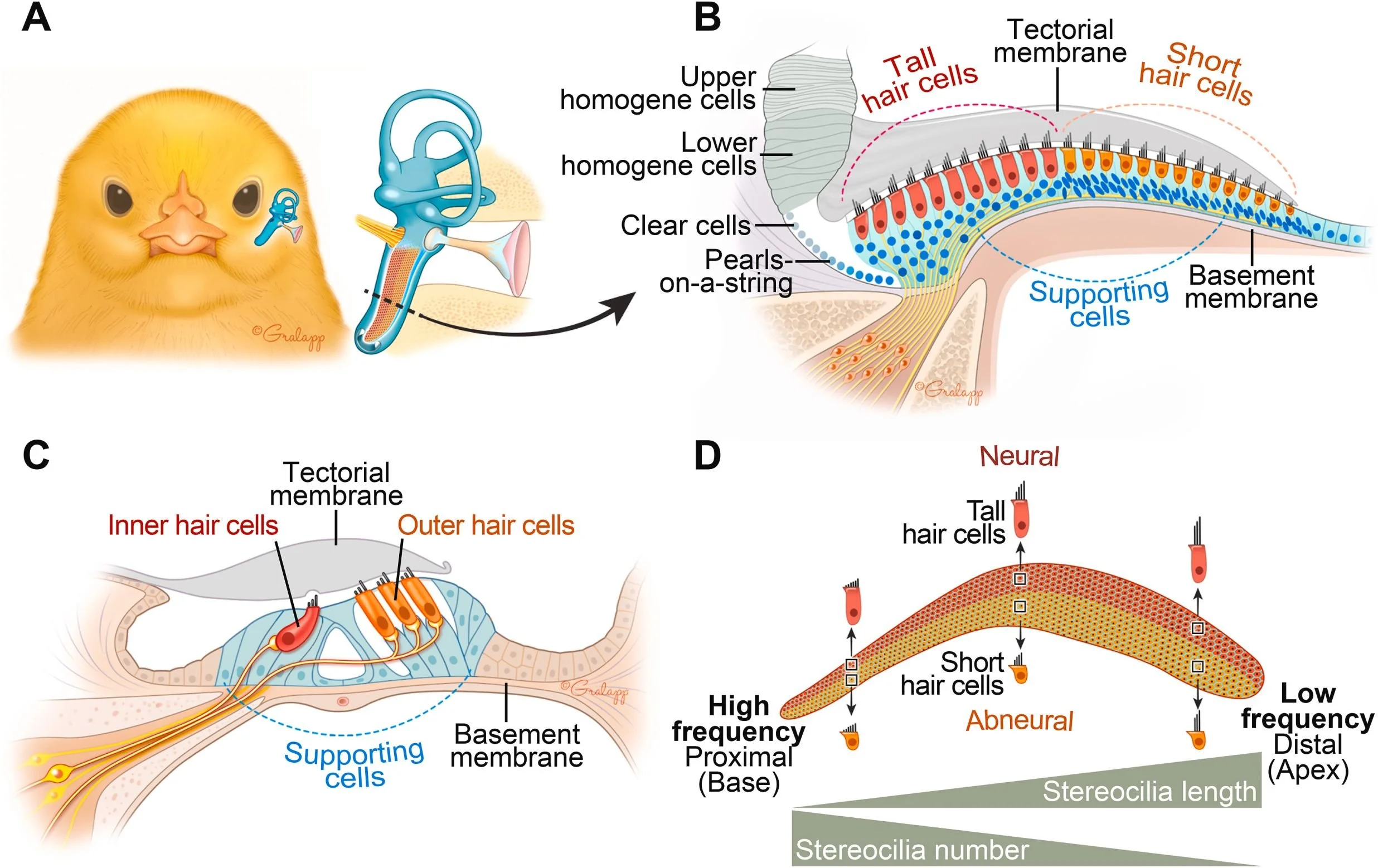By Nesrine Benkafadar, Ph.D.
Hearing loss caused by the loss of inner ear sensory hair cells remains an incurable condition for millions worldwide; however, nature offers a remarkable solution. Birds naturally possess an extraordinary ability to completely regenerate these sound-detecting cells throughout their lives—a capability humans lose shortly after birth.
Our comprehensive review in Developmental Biology, published online in May and in print in September 2025, examines decades of research into this biological phenomenon, revealing exciting possibilities for future hearing restoration therapies.
Comparative anatomy of the avian basilar papilla (A and B) and mammalian cochlea (C and D). Credit: Miranda Portillo et al./Developmental Biology
The avian inner ear contains specialized supporting cells that employ two distinct regenerative strategies after damage. Some cells divide to create new hair cells, while others transform directly into functional hair cells without cell division.
This dual-mechanism system ensures complete hearing recovery. What makes these findings particularly significant is that humans possess nearly identical cell types, suggesting our bodies retain—but fail to activate—similar regenerative potential.
Key differences between species help explain why birds regenerate hair cells while humans cannot. In mammals, supporting cells develop rigid structural components that appear to physically block regeneration.
Furthermore, while birds activate specific molecular pathways to enable repair, these same pathways seem inhibited in mammals—possibly by cellular properties we don't yet fully understand. Birds maintain more flexible cellular architectures and have evolved precise mechanisms to temporarily lift these growth restrictions when regeneration is needed.
Research has not yet fully explained the mechanisms behind efficient hair cell regeneration in birds, but recent discoveries have sparked multiple promising research directions that might bring us closer to developing treatments for humans.
For instance, our fellow scientists in Hearing Health Foundation’s Hearing Restoration Project are exploring ways to increase cellular flexibility in mammalian ears, developing compounds to temporarily inhibit growth-suppressing signals, and investigating gene therapies that could introduce regenerative capabilities.
Advances in modern technology, such as single-cell RNA sequencing, will continue to offer insights into the complex details underlying regenerative processes in birds, which in turn will help identify potential drug targets that could eventually enable hair cell regeneration in mammals.
While significant challenges remain—particularly in improving efficiency, ensuring safety, and guaranteeing that regenerated cells function properly—the fundamental scientific progress in the field offers genuine hope.
Current hearing aids and cochlear implants merely compensate for damage rather than repair it. The avian model suggests that an authentic biological restoration may be possible. As research continues to decode nature’s solutions, we move closer to potential therapies that could one day transform hearing loss from a permanent condition to a treatable one.
Hearing Health Foundation leads the way in supporting potentially groundbreaking research, bringing us closer to a future where hearing restoration is achievable for millions. It’s not a question of if but when. Sadly, the number of research labs focused on these critical issues is small, and funding levels are low.
More resources and attracting additional scientists to the field could significantly accelerate discoveries. As researchers, we genuinely want to progress faster, and seeing human treatments within our lifetimes would be deeply rewarding. Even earlier would be ideal!
Nesrine Benkafadar, Ph.D., is an instructor in the lab of study coauthor and Hearing Restoration Project member Stefan Heller, Ph.D., who is a professor of otolaryngology–head & neck surgery at Stanford University and a 2001–2002 Emerging Research Grants scientist.








Which noises should we be aware of this holiday season?